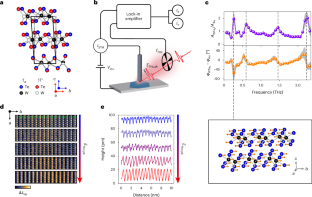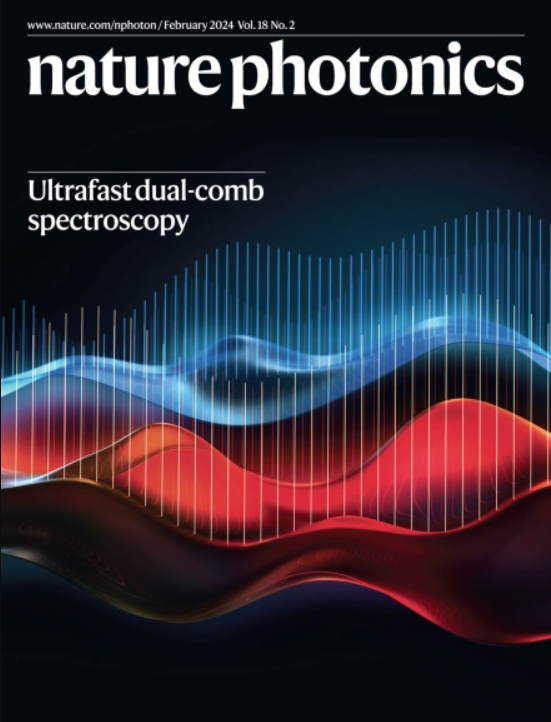Terahertz field control of surface topology probed with subatomic resolution
IF 32.9
1区 物理与天体物理
Q1 OPTICS
引用次数: 0
Abstract
Light-induced phase transitions offer a method to dynamically modulate topological states in bulk complex materials. Yet, next-generation devices demand nanoscale architectures with contact resistances near the quantum limit and precise control over local electronic properties. The layered material WTe2 has gained attention as a probable Weyl semimetal, with topologically protected linear electronic band crossings hosting massless chiral fermions. Here we demonstrate a local phase transition facilitated by the light-induced shear motion of a single atomic layer at the surface of bulk WTe2, thereby opening the door to nanoscale device concepts. Ultrafast terahertz fields enhanced at the apex of an atomically sharp tip couple to the key interlayer shear mode of WTe2 via a ferroelectric dipole at the interface, inducing a structural phase transition at the surface to a metastable state. Subatomically resolved differential imaging, combined with hybrid-level density functional theory, reveals a shift of 7 ± 3 pm in the top atomic plane. Tunnelling spectroscopy links electronic changes across the phase transition with the electron and hole pockets in the band structure, suggesting a reversible, light-induced annihilation of the topologically protected Fermi arc surface states in the top atomic layer. A terahertz field exceeding 1 V nm−1 induced a structural phase transition in the top atomic layer of a bulk WTe2 crystal. Differential imaging revealed a surface shift of 7 ± 3 pm and an electronic signature consistent with a topological phase transition.


以亚原子分辨率探测的表面拓扑的太赫兹场控制
光诱导相变提供了一种动态调制块状复杂材料拓扑态的方法。然而,下一代设备需要纳米级架构,接触电阻接近量子极限,并精确控制局部电子特性。层状材料WTe2作为一种可能的Weyl半金属而引起了人们的注意,其拓扑保护的线性电子带交叉点承载无质量手性费米子。在这里,我们展示了在块体WTe2表面的单原子层的光诱导剪切运动促进的局部相变,从而打开了纳米级器件概念的大门。在原子尖顶端增强的超快太赫兹场通过界面上的铁电偶极子耦合到WTe2的关键层间剪切模式,诱导表面的结构相变到亚稳态。亚原子分辨差分成像,结合混合能级密度泛函理论,揭示了顶部原子平面7±3 pm的位移。隧穿光谱将电子在相变中的变化与能带结构中的电子和空穴口袋联系起来,表明在顶层原子层中受拓扑保护的费米弧表面态存在可逆的光诱导湮灭。
本文章由计算机程序翻译,如有差异,请以英文原文为准。
求助全文
约1分钟内获得全文
求助全文
来源期刊

Nature Photonics
物理-光学
CiteScore
54.20
自引率
1.70%
发文量
158
审稿时长
12 months
期刊介绍:
Nature Photonics is a monthly journal dedicated to the scientific study and application of light, known as Photonics. It publishes top-quality, peer-reviewed research across all areas of light generation, manipulation, and detection.
The journal encompasses research into the fundamental properties of light and its interactions with matter, as well as the latest developments in optoelectronic devices and emerging photonics applications. Topics covered include lasers, LEDs, imaging, detectors, optoelectronic devices, quantum optics, biophotonics, optical data storage, spectroscopy, fiber optics, solar energy, displays, terahertz technology, nonlinear optics, plasmonics, nanophotonics, and X-rays.
In addition to research papers and review articles summarizing scientific findings in optoelectronics, Nature Photonics also features News and Views pieces and research highlights. It uniquely includes articles on the business aspects of the industry, such as technology commercialization and market analysis, offering a comprehensive perspective on the field.
 求助内容:
求助内容: 应助结果提醒方式:
应助结果提醒方式:


